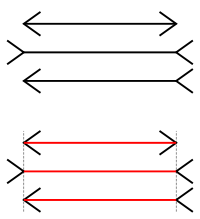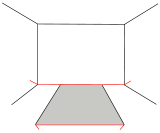
Mueller-Lyer illusion
Encyclopedia

Optical illusion
An optical illusion is characterized by visually perceived images that differ from objective reality. The information gathered by the eye is processed in the brain to give a perception that does not tally with a physical measurement of the stimulus source...
consisting of a stylized arrow. When viewers are asked to place a mark on the figure at the mid-point, they invariably place it more towards the "tail" end. It was devised by F.C. Müller-Lyer in 1889.
A variation of the same illusion (and the most common form in which it is seen today, see figure) consists of a set of arrow-like figures. Straight line segments comprise the "shafts" of the arrows, while shorter line segments (called the fins) protrude from the ends of the shaft. The fins can point inwards to form an arrow "head" or outwards to form an arrow "tail". The line segment forming the shaft of the arrow with two tails is perceived to be longer than that forming the shaft of the arrow with two heads.
Variation in Perception
It has been shown that perception of the Müller-Lyer illusion varies across cultures and age groups.Segall, Campbell and Herskovitz compared susceptibility to four different visual illusions in three population samples of Caucasians, twelve of Africans, and one from the Philippines. For the Müller-Lyer illusion, the mean fractional misperception of the length of the line segments varied from 1.4% to 20.3%. The three European-derived samples were the three most susceptible samples.
It has been suggested that the cross-cultural variation in the perception of the Müller-Lyer illusion is due to differences in the familiar objects of the subjects' environments. In Western cultures full of rectilinear shapes (the so-called "carpentered world"), subjects perceive the lines as representing the corners of rectilinear objects viewed in perspective.
A later study was conducted by Ahluwalia on children and young adults from Zambia. Subjects from rural areas were compared with subjects from urban areas. The subjects from urban areas were shown to be considerably more susceptible to the illusion, as were younger subjects. While this by no means confirms the carpentered world hypothesis as such, it provides evidence that differences in the environment can create differences in the perception of the Müller-Lyer illusion, even within a given culture.
Experiments have been reported suggesting that pigeons perceive the standard Müller-Lyer illusion, but not the reversed. Experiments on parrots have also been reported with similar results.
The perspective explanation

Richard Gregory
Richard Langton Gregory, CBE, MA, D.Sc., FRSE, FRS was a British psychologist and Emeritus Professor of Neuropsychology at the University of Bristol.-Life and career:...
, states that the Müller-Lyer illusion occurs because the visual system processes that judge depth and distance assume in general that the “angles in” configuration corresponds to an object which is closer, and the “angles out” configuration corresponds to an object which is far away. Basically, there seems to be a simple heuristic
Heuristic
Heuristic refers to experience-based techniques for problem solving, learning, and discovery. Heuristic methods are used to speed up the process of finding a satisfactory solution, where an exhaustive search is impractical...
that takes those configurations as 90° angles. This heuristic speeds up the interpretation process, but gives rise to many optical illusions in unusual scenes. A recent report by Catherine Howe and Dale Purves summarizes current thinking on Gregory's ideas:
Although Gregory's intuition about the empirical significance of the Müller-Lyer stimulus points in the right general direction (i.e., an explanation based on past experience with the sources of such stimuli), convex and concave corners contribute little if anything to the Müller-Lyer effect.
Neural nets in the visual system of human beings learn how to make a very efficient interpretation of 3D
Three-dimensional space
Three-dimensional space is a geometric 3-parameters model of the physical universe in which we live. These three dimensions are commonly called length, width, and depth , although any three directions can be chosen, provided that they do not lie in the same plane.In physics and mathematics, a...
scenes. That is why when somebody goes away from us, we do not perceive him as getting shorter. And when we stretch one arm and look at the two hands we do not perceive one hand smaller than the other. We should not forget that, as visual illusions show us quite clearly, what we see is an image created in our brain. Our brain projects the image of the smaller hand to its correct distance in our internal 3D model. This is what is called the size constancy mechanism.
In the Müller-Lyer illusion, the visual system would in this explanation detect the depth cues, which are usually associated with 3D scenes, and incorrectly decide it is a 3D drawing. Then the size constancy mechanism would make us see an erroneous length of the object which, for a true perspective
Perspective (visual)
Perspective, in context of vision and visual perception, is the way in which objects appear to the eye based on their spatial attributes; or their dimensions and the position of the eye relative to the objects...
drawing, would be farther away.
In the perspective drawing in the figure, we see that in usual scenes the heuristic works quite well. The width of the rug should obviously be considered shorter than the length of the wall in the back.

